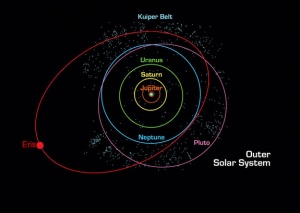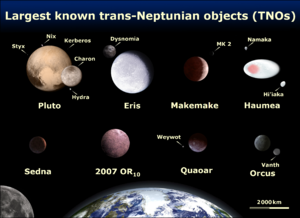Kuiper Belt
The Kuiper Belt, sometimes called the Edgeworth–Kuiper belt, is a circumstellar disc in the Solar System beyond the planets, extending from the orbit of Neptune (at 30 AU) to approximately 50 AU from the Sun. It is similar to the asteroid belt, but it is far larger—20 times as wide and 20 to 200 times as massive. Like the Asteroid Belt, it consists mainly of small bodies, or remnants from the Solar System's formation. Although many asteroids are composed primarily of rock and metal, most Kuiper belt objects are composed largely of frozen volatiles (termed "ices"), such as methane, ammonia and water. The Kuiper belt is home to three officially recognized dwarf planets: Pluto, Haumea, and Makemake. Some of the Solar System's moons, such as Neptune's Triton and Saturn's Phoebe, are also thought to have originated in the region.
The Kuiper belt should not be confused with the theorized Oort cloud, which is a thousand times more distant and is mostly spherical. The objects within the Kuiper belt, together with the members of the scattered disc and any potential Hills cloud or Oort cloud objects, are collectively referred to as trans-Neptunian objects (TNOs).
Pluto is the largest and most-massive member of the Kuiper belt and the largest and the second-most-massive known TNO, surpassed only by Eris in the scattered disc.Originally considered a planet, Pluto's status as part of the Kuiper belt caused it to be reclassified as a dwarf planet in 2006. It is compositionally similar to many other objects of the Kuiper belt, and its orbital period is characteristic of a class of KBOs, known as "plutinos", that share the same 2:3 resonance with Neptune. [1]
The presence of Neptune has a profound effect on the Kuiper belt's structure due to orbital resonances. Over a timescale comparable to the age of the Solar System, Neptune's gravity destabilises the orbits of any objects that happen to lie in certain regions, and either sends them into the inner Solar System or out into the scattered disc or interstellar space.
Largest Kuiper Belt Objects (KBO)
Since 2000, a number of KBOs with diameters of between 500 and 1,500 km (932 mi), more than half that of Pluto (diameter 2370 km), have been discovered.The discovery of these large KBOs in similar orbits to Pluto led many to conclude that, aside from its relative size, Pluto was not particularly different from other members of the Kuiper belt. Not only are these objects similar to Pluto in size, but many also have satellites, and are of similar composition (methane and carbon monoxide have been found both on Pluto and on the largest KBOs). Thus, just as Ceres was considered a planet before the discovery of its fellow asteroids, some began to suggest that Pluto might also be reclassified.
The issue was brought to a head by the discovery of Eris, an object in the scattered disc far beyond the Kuiper belt, that is now known to be 27% more massive than Pluto. (Eris was originally thought to be larger than Pluto by volume, but the New Horizons mission found this not to be the case.) In response, the International Astronomical Union (IAU), was forced to define what a planet is for the first time, and in so doing included in their definition that a planet must have "cleared the neighbourhood around its orbit". As Pluto shared its orbit with so many KBOs, it was deemed not to have cleared its orbit, and was thus reclassified from a planet to a member of the Kuiper belt.
Although Pluto is currently the largest known KBO, there is at least one known larger object currently outside the Kuiper belt that probably originated in it: Neptune's moon Triton (which, as explained above, is probably a captured KBO).
Secret Space Stations
The Kuiper Belt is the location of several secret space stations that are used as an intermediary point for holding assemblage, interdimensional planetary meetings, such as instigating diplomatic negotiations and for ambassadorial purposes that serve for a variety of different species, interests and factions.



